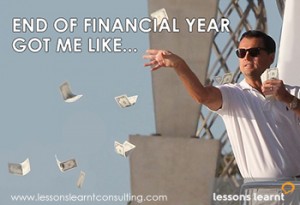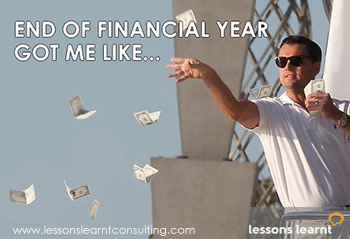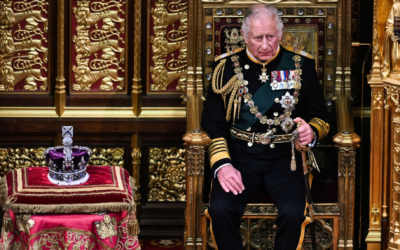It’s the consultants’ Christmas!
It’s that most wonderful time of the year where clients are desperately spending their budgets prior to the end of the financial year.

It’s that time of the year where as consultants we also source funding from our clients to continue the work we have been doing with them.
I am in the middle of a major change management project for a national organisation. A large piece of the work is about building individual resilience to assist employees bounce through the mergers and acquisitions, reengineering processes, restructuring, in-house work outsourcing, redundancies, redefinition of product lines and so forth – all part of the change process.
Fortunately, when we started the project in 2015, the CEO and I had a frank conversation about the investment required to ensure the project was to make the contribution required by the business. At that point, he requested a “defendable” business plan for the project over a four-year period as he knew that other senior managers and most probably, the Board, would be asking questions as to the return from such a strategy. I remember him saying “Dennis, you know what they are going to have a crack at you about…not one single sale will be made…these “feel good programs don’t work….”
His request was simple – back your project and make it secure.
So how do you build a business case to support and defend a change management program with a key message around personal emotional resilience?
While I assume there are many, I can only share with you my experience in the hope it may be of some value. The approach I took after building the plan around key result areas, key strategies and major actions, was to focus on the key performance indicators – what could my client expect to see as a result of this strategy.
I structured the KPIs around three levels:
- Strategic
- Tactical
- Operational.
This is a handy framework used to justify and defend a change management program built around personal resilience.
Strategic: Is the program delivering on what we said it would? We said that this strategy would make individuals within the organisation more change welcoming, resulting in adoption and integration of new practices within the business. Did it? Is it? How do you know?
Our indicators are applied internal and external to the business. Internally, is there a rise in change welcoming culture as measured by the internal multisource feedback mechanism? Is the business seeing (or more precisely perceiving) a quicker sign on and pick up of the changes? Do the internal climate surveys indicate that people are more change welcoming, feel that they understand and are engaged? Are these changes generating a return and how quickly is it taking to make money?
Are the providers and external suppliers, as measured by specific questions in formal post implementation reviews, seeing more engagement and less resistance to changes – are employees highlighting issues and working with these suppliers and providers in ensuring a more rapid implementation of the changes? Are employees being part of the process – as opposed to being apart?
Tactical: Are there signs of behavioural change that demonstrate a more change welcoming culture? Do the performance reviews reflect the messages and measure of resilience? Do the people management practices around recruitment, retention and development reflect the competencies identified as required to ensure future organisational efficiencies. To what extent are the exit interviews reflecting a culture that treated people with respect and honour? Are resilience and other wellbeing topics part of the standard team meeting agendas and “toolbox” meetings? What are the issues being fed back to the organisation by providers such as the Employee Assistance Providers (EAP) and as importantly, how quickly is the organisation and teams responding to these issues? What are people saying about the business and their leaders around wellbeing surveys conducted within the business? Are the nature of the issues changing from a negative to a positive bias? Are more people participating in these surveys?
Operational: These are the straight out, but important transactional measures. How many training sessions on managing change and resilience strategies were conducted? How many people attended? How many managers volunteered to be trained as a “wellbeing mentor”. Did measures such as absenteeism, resignations (of key people), OHS measures around lost time injuries etc. go in the direction where we needed them to go to? Were internal and external support programs such as EAP better supported within the business? Are teams having meetings? To what extent are people self-nominating for training around change management, wellbeing and resilience competencies?
I found the more challenging part of this project was to create and gain acceptance to the KPI framework around the strategy. I found that measuring these actions and behaviours was the easier part of the project as many of these measures already existed or at least the mechanisms existed and they just needed a tweak to reflect our interest in the success of the change management/resilience strategy.
There was one unintended, but in retrospect should not have been unexpected, consequence of implementing this framework. It goes back to the old management adage – “what gets measured gets done”. Because we were measuring behaviour through these three levels; behaviour started to change – not only through the implementation of the strategy but through discussing progress and results.
Behaviour actually changed by the existence of the KPI framework! How good is that!
So, I hope this Strategic/Tactical/Operational framework assists you in your endeavours. If you talk the language of business, business starts to talk your language.
Happy to discuss the lessons we learnt in our own experience of managing this change and creating this framework.
Oh! And an email was received this morning thanking Lessons Learnt Consulting for our efforts in 2016/17 and confirming the continued roll out of the strategy in 2017/18!
Merry Christmas to all!






